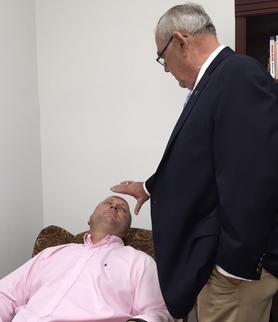Athletic Performance
You can reach your personal best.
Olympic athletes use self-hypnosis to help them achieve top performance. Sports professionals in the United States and many other nations recognize that the power of mental rehearsal is equally as important as physical endurance and practice. Many professional sports teams are taught mental conditioning from the start of their training. For the average person, hypnotherapy cannot turn a beginning golfer into a PGA champion. Of course, other factors such as an individual’s skills and abilities are involved. But hypnosis can be used to enable a player to achieve his or her personal best!
For many years now, professional athletes have been using the tool of hypnosis to gain the mental edge on their opponents. It is reported that Tiger Woods’ mental coach, Dr. Jay Brunza, began hypnotizing him at age 13 to block out distractions and focus completely on the golf course. Championship golfer Jack Nicklaus shared that hypnotherapy and visualization techniques were the sole reason for his improved concentration. Others in professional sports, including Michael Jordan, Wayne Gretzky, Ken Norton, Andre Agassi, Kobe Bryant, Shaq O’Neal, Mike Tyson, along with Nolan Ryan, George Brett, and Mark McGwire, all reported using hypnosis to be able to relax and focus before competing.
What the mind can conceive, the body can achieve! Proof of that statement has been provided countless times. Athletes can picture a perfect performance in their mind and then the body can produce it. The same capability is available to any sports enthusiast. Even if skills and coordination abilities do not equal professional or Olympic levels, they can carry the players to the heights of personal best by providing new levels of achievement and satisfaction. To train the body to the limits of its capabilities without simultaneously training the mind is to invite, at best, mediocrity. For decades, sports psychologists have claimed that 80% of an Olympic athlete’s performance is in the mind. This belief has been echoed by championship players in virtually every form of competition.
What the mind can do:
Mental rehearsal, also termed visualization, can create and reaffirm the confidence necessary to achieve top performance. The picture visualized in the mind can convince the subconscious that achievement is possible. The autonomic nervous system performs in exactly the same manner followed during a physical rehearsal. Neuromuscular coordination improves. What your mind can conceive, you can achieve. If you can think it and see it in your mind, you can do it!
What can be accomplished through the powers of the mind? Perhaps most important is the development of positive attitudes. Negative thoughts pertaining to performance skills can be changed or eliminated. Enjoyment of the sport will be enhanced as skills improve to the point where intermittent incidence of poor performance no longer arouse irritation, anger, discouragement or detrimental emotional reaction. Concentration, coordination, technique all can improve as well as awareness of proper form and posture. Sports enthusiasts face the same stumbling blocks that people deal with in other areas of life – business, personal relationships, achievement of goals and ambitions. The biggest of all is fear, and fear comes in many forms. Fear of failure is always restrictive and is very common in sports, as is its hidden partner, fear of success – an apprehension that success can create the expectation (among others) of further improvement. Fear of humiliation can be strong. Many golfers experience near terror on the first tee where people may be watching the first drives. Competition can produce sensations of intimidation resulting in deterioration of skills.
Hypnotherapy, or properly learned and applied self-hypnosis, can work to reduce or eliminate the mental obstacles to peak performance in sports activities. This is an area in which the truth of the phrase “what the mind can conceive, the body can achieve” becomes highly evident.
The steps to achievement:
The goal of hypnosis and its applications is not the learning or acquisition of the basic skills involved, though these could be helped through hypnosis as used in enhanced learning skills. The goal is to enable the athlete to achieve the best personal level, performing at peak. As with virtually all hypnosis, the first step must be relaxation. Relaxation to a level appropriate for the implanting of hypnotic suggestion is not really resting. It is deep, and can be brought about through a hypnotherapist.
Goal-setting is essential. Without having an objective, it is pointless to begin a task, project or trip. Goals may be set by athletes, coaches or therapists or a combination there-of. It is important for goals to be specific, focused on the area in which improvement is desired. Playing better tennis is not a valid goal. Goals must be short- term achievable and step by step, so that both success and completion are experienced.
Focused concentration is vitally important, and sometimes difficult to develop. Hypnotherapy has long been an effective means of improving concentration capabilities. Distractions must be eliminated. Post-hypnotic suggestions may prove useful in stimulating both focused concentration and specific skills. Visualization, not just in mental rehearsing, but at the moment of performance, can produce dramatic results.
Finally, mental rehearsal is the ultimate key to superlative performance. It can prove more productive than physical practice. Imagery is not merely visual in nature; it can include all the senses. In a diving competition, the form of the dive is visual; the smell of the chlorine water is olfactory; the wetness of the entry is sensory, the cheers of the crowd are auditory. Perfection requires the use of all senses.
Professional membership in the National Guild of Hypnotists signifies that an individual possesses specific qualifications, agrees to abide by a strict code of ethics, and will pursue continuing-education studies for annual recertification. Referrals may be required for certain conditions, in certain locations. This brochure is distributed as a public information service by its members.
